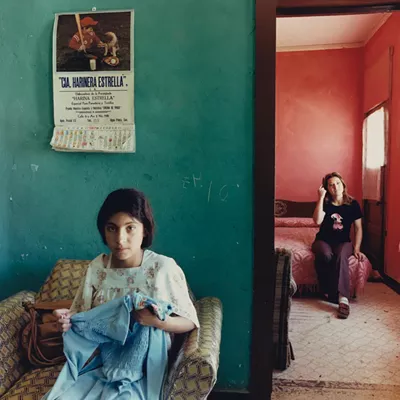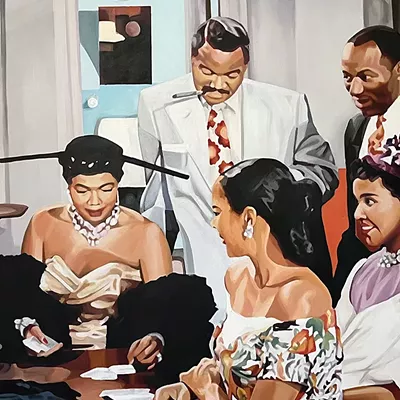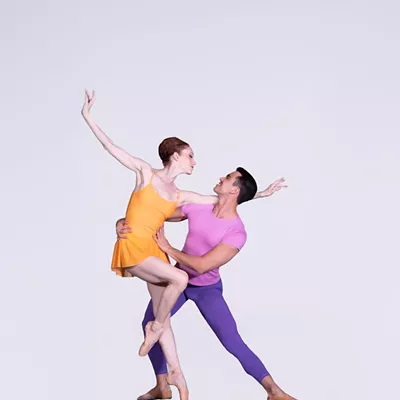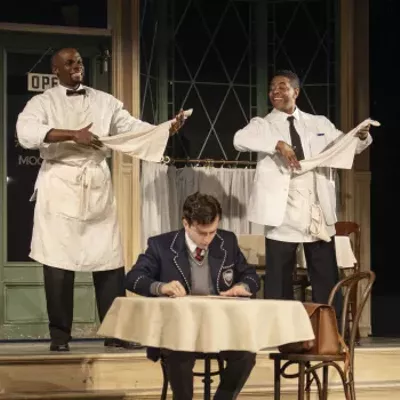In the Ballet Tucson studio, the young choreographer tried out multiple solutions. She had five dancers trace out parallel lines by leaping all in one direction. She fractured the line and split the dancers into two groups moving in opposite directions. And she had them trace out arcs across the floor before breaking through intersecting lines.
"I don't want an actual jump," she called out to the dancers as they sautéd and pliéd to an exhilarating J.S. Bach concerto for violin and strings. "Go up on two, and dig the toe into the ground. Go piqué. Fouetté. Step back." She paused. "Let's work out the walking pattern."
Normally, Jalbert, just 23, is a dancer with the company, but she was relishing the chance to try choreography. She's one of seven troupe members who will debut their original dances at the Temple of Music and Art at this Saturday's concert, ROCS III: Roots of Choreography Showcase--Dances From the Heart. The Valentine's Day show will conclude with a candlelight reception dripping with champagne and chocolate.
"I danced with Alabama Ballet for three seasons, and they used to do a show like this," Jalbert said, once she'd closed off the circle and dismissed her dancers. "But only senior members could do it. It's great that in this show, anyone can."
Now in its third year, ROCS is the brainchild of executive director Jeffrey Graham Hughes. "I developed the concept in Ohio"--when he was artistic director of Ohio Ballet--"and transferred it to Tucson," he explained. "It's career development for the dancers. They choreograph on each other. It's very valuable."
And for the audience, he added, "It's a great opportunity to see brand-new, fresh dancing from young people at the start of their career."
The dancers who opted to metamorphose into choreographers were given certain limits. They had to make their pieces short, between three and eight minutes long; they couldn't use more than eight dancers; and they had to set their pieces to classical music.
"The assignment was to work with established classical music: Bach, Rachmaninov, Vivaldi and so on," Hughes said. "We thought it would be good to challenge them with classical music, to make them use music they wouldn't really do on their own." The musical education will serve them in good stead, he added, if they ever get choreographic commissions down the road.
Jalbert also participated last year; the rules then allowed choreographers to choose any music they wanted. But she liked the discipline imposed this time around. "To be a well-rounded dancer, you need to know classical music," she said. Interestingly, she and two others all chose the same piece, and she had to switch to the Bach concerto, which has the virtue of being eminently danceable.
Like Jalbert's eight-minute ballet, most of the 13 works on the program are "classically based," Hughes said. Modern dance gets most of the attention for new choreography nowadays, he said, and ballet ought to keep pace. "It's important to develop our field, to keep the ballet part of the dance world fresh."
Just to keep things interesting, local modern troupe Thom Lewis Dance will stop by to dance a raucous contemporary piece. Amy Barr-Holm, a Lewis dancer, will contribute her "Standing Water," a trio to music by the not-at-all classical Radiohead. The choreography is not exactly classical, either.
"They take a big piece of plastic, throw water on it, and then slide around," Lewis explained. "It's four minutes long." Lewis added that his troupe, which just started up last year, was "honored to have been invited."
Ballet Tucson wanted Thom Lewis Dance for the variety. "It's a nice opportunity to reach out in our community and give visibility to another organization. All our choreographers are ballet-based with broad training."
All 18 Ballet Tucson members will dance in the show, which also features a guest appearance by Pacific Northwest Ballet apprentice dancer Margaret Mullin, a former company member who grew up in Tucson and trained at the troupe's Ballet Arts school. Mullin will bring along PNB dancer Andrew Bartee to partner in a classical pas de deux. Ashley Bowman, another former Ballet Tucson dancer now studying for her MFA at the UA School of Dance, contributes a work, as do several advanced students in the troupe's school.
The short works vary, going back and forth from solos to pas de deux to multiple-dancer works. Jalbert set herself the difficult problem of moving five bodies across the stage, she said, in part to avoid the even harder task of working with coupled partners. "I'm more comfortable choreographing on single people than on a couple," she said. "For a couple, there are a lot of logistical things."
One studio over, the company's husband-and-wife stars, Daniel Precup and Jenna Johnson, were working out those logistical problems in their own couples dance. Precup gets choreography credit for the romantic pas de deux, set to an aria from the opera Rusalka by Dvorák. A woman with a lush soprano sang in Czech as the muscled pair sweated and worked, repeating jetés and battements.
The dancers spoke softly to one another in a mixture of Romanian and English. (Johnson, an American, met Precup in Romania when she went to his native country to dance.) They were working on a difficult leap. The ballerina was to jump backward into the danseur's waiting arms, and then he was to raise her over his head. They missed a couple of times. "Jump up," Precup urged. And then she did, soaring so high into space that her hand almost hit the studio ceiling.













